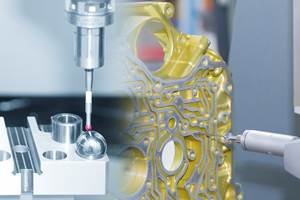Sliced Bread—And The Limits Of Air Gaging
"Air gaging is the greatest thing since sliced bread," a friend once said. And he was right—air gaging is good.
Share






"Air gaging is the greatest thing since sliced bread," a friend once said. And he was right—air gaging is good. It's fast, high resolution, non-contact, self-cleaning and easy to use. For use in a high-volume shop, it's hard to beat. That begs the question, "If air gaging is so good, why would you ever consider going back to contact type gaging?"
The answer is that while air gaging does provide all of the benefits listed above, it—and everything else that obeys the laws of physics—has some limitations. There are, in short, some trade-offs, and for every advantage you gain in the measuring process with air, you will have to pay the price and sacrifice something else. The real question is, "What are those limitations, and how can you best work with them?"
Air gaging gives you a fast measurement device that provides superior reliability in the dirtiest shop environment, but you give up things such as measurement range and a clear delineation of surface. Air gaging has about 10 to 20 percent of the range of a typical electronic transducer with similar resolution.
The response of air to surface finish, however, is more complicated. Think of an air jet. The measurement ‘point' is really the average area of the surface the jet is covering. Now consider the finish, or roughness, of that surface. The measurement point of the air jet is actually the average of the peaks and valleys to which the jet is exposed. This is not the same measured point you have if a contact-type probe is used. This difference is a source of real gaging error, and one that is most often apparent when two different inspection processes are used.
For example, let's say we have a surface finish of 100 microinches on a part and we're measuring with an air gage comparator and two-jet air plug that has a range typically used to measure a 0.003-inch tolerance. The typical gaging rule says you should have no sources of error greater then 10 percent of the tolerance. In this example, that's 0.0003 inch. If we used this plug on the 100-microinch surface, the average measuring line is really 50 microinches below the peak line. Double this error with two jets and you get 0.0001 inch or 30 percent of the allowable error. That's pretty significant, so air would probably not be a good choice for this part. In general, the limit for surface finish with an air gage is about 60 microinches, but it really depends on the part tolerance.
This source of error should also be considered when setting the plug and comparator to pneumatic zero. If the master and the part have similar surface finishes, then there is little problem. Most master rings are lapped to better than a 5-microinch finish. However, if the gage is now used on a 200-microinch finish part, there would be significant error introduced. For most applications, there should be no more than 50 microinches difference between the master and the part the gage is measuring. Even this can be significant if the tolerance of the part is as little as 0.001 inch.
In some applications, air gaging can be the best thing since sliced bread. In others, you can get in trouble with the butter. When measuring porous surfaces, narrow lands, and areas extremely close to the edge of a hole, stick with a fixed size, mechanical plug with probe contacts.
Related Content
6 Machine Shop Essentials to Stay Competitive
If you want to streamline production and be competitive in the industry, you will need far more than a standard three-axis CNC mill or two-axis CNC lathe and a few measuring tools.
Read More4 Ways to Establish Machine Accuracy
Understanding all the things that contribute to a machine’s full potential accuracy will inform what to prioritize when fine-tuning the machine.
Read MoreRethink Quality Control to Increase Productivity, Decrease Scrap
Verifying parts is essential to documenting quality, and there are a few best practices that can make the quality control process more efficient.
Read MoreUsing Digital Tap Testing to Measure Machining Dynamics
Tool-toolholder-spindle-machine combinations each have a unique vibration response. We can measure the response by tap testing, but we can also model it.
Read MoreRead Next
Last Chance! 2025 Top Shops Benchmarking Survey Still Open Through April 30
Don’t miss out! 91ÊÓƵÍøÕ¾ÎÛ's Top Shops Benchmarking Survey is still open — but not for long. This is your last chance to a receive free, customized benchmarking report that includes actionable feedback across several shopfloor and business metrics.
Read MoreMachine Shop MBA
Making Chips and 91ÊÓƵÍøÕ¾ÎÛ are teaming up for a new podcast series called Machine Shop MBA—designed to help manufacturers measure their success against the industry’s best. Through the lens of the Top Shops benchmarking program, the series explores the KPIs that set high-performing shops apart, from machine utilization and first-pass yield to employee engagement and revenue per employee.
Read MoreAMRs Are Moving Into Manufacturing: 4 Considerations for Implementation
AMRs can provide a flexible, easy-to-use automation platform so long as manufacturers choose a suitable task and prepare their facilities.
Read More


















